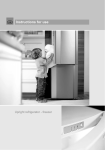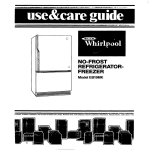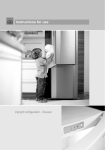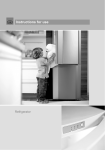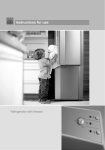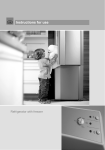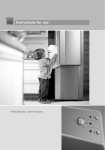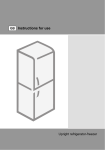Download Smeg UKC375XNF fridge-freezer
Transcript
Instructions for use Upright refrigerator - freezer Thank you for your confidence in buying our appliance and congratulations on the excellent choice. We hope it will successfully serve its purpose for many years. Upright refrigerator - freezer (hereinafter: the appliance) is combined from two parts: top part is refrigerator and bottom part is upright freezer. Refrigerator is used in households for storage of fresh food at temperatures above 0°C). Freezer is used in households for freezing fresh food and storage of frozen food for up to one year (depending on the type of food). 142468 Before first operation ........................................ 3 Description of the appliance ............................ 5 Installation and connection .............................. 7 Reverse door swing ........................................ 9 Control panel .................................................. 11 Recommended distribution of food .............. 22 Storing fresh food ......................................... 23 Freezing and storage of frozen food ............. 25 Defrosting the appliance................................. 28 Cleaning ........................................................... 29 Troubleshooting guide .................................... 30 Noise level ........................................................ 32 2 Before first operation • Before connecting the appliance read these instructions carefully. They 142468 describe the appliance and provide instructions for its safe and correct use. The instructions are prepared for different types and models of the appliance so they may contain descriptions of functions and components your appliance may not have. Instructions also contain the NO FROST freezer version, with integrated fan and automatic defrost. • Remove the wrapping protecting the appliance during transport. • Door corners are fitted with protective spacers. Remove the spacers and replace them with the attached pegs (certain models only). • Before connecting the appliance to the mains supply, leave it in upright position for about 2 hours. This will reduce possibility of malfunctions in the cooling system resulting from prior transport and handling. • The appliance must be connected to the mains supply in accordance with the standing regulations and local requirements. • The appliance must not be used in open air or exposed to weather precipitation. • Always disconnect the appliance from power supply (pull the power cord from wall socket) before cleaning and before replacing the light bulb. • If the power supply cord is damaged, in order to avoid hazard it must be replaced by the service or by qualified personnel. • In event of long periods without use, switch off the appliance off with the ON/ OFF button and disconnect it from mains supply. Empty the appliance, clean the interior and leave the door ajar. • For the protection of environment, please contact local Borough or Council for correct disposal arrangements. • Wrappings contain environmentally friendly materials which can be recycled, recovered or disposed without threat to the environment. • To prevent any pollution be careful not to damage the insulation or refrigeration tubes at the rear wall during the installation, cleaning and disposal of the appliance. • Never let the children play with the appliance. • Self closing door hinge (certain models only) pulls the door to the cabinet just before closing, thereby preventing the door to remain ajar. Equally it limits the door opening angle and prevents damage to adjacent elements. • Rating plate with basic information is located in the interior of the appliance. If the sticker plate is not suitable for your language, replace it with the attached one. 3 The symbol on the product or on its packaging indicates that this product may not be treated as household waste. Instead it shall be handed over to the applicable collection point for the recycling of electrical and electronic equipment. By ensuring this product is disposed of correctly, you will help prevent potential negative consequences for the environment and human health, which could otherwise be caused by inappropriate waste handling of thisproduct. For more detailed information about recycling of this product, please contact your local city office, your household waste disposal service or the shop where you purchased the product. 142468 4 Description of the appliance A Refrigerator (traditional and NO FROST appliance) 1 Control panel 2 Fan* 3 Interior illumination light 4 Shelf (adjustable height) 5 Foldable egg tray (closed 6, open 12 eggs) 6 Crisp tray 7 Door trays (options: deep, shallow, cover or no cover) 8 Bottle tray with holder 15 Leg* 16 Wheel* B Freezer (traditional appliance) 9 Freeze drawer* 10 Storage drawer 11 Storage drawer 12 Door tray 13 Ice tray 14 Defrost water groove* B Freezer (NO FROST appliance) 9 Storage drawer* 10 Freeze drawer • Interior accessories of the appliance may vary according to the model. • Drawers are protected against accidental extraction. To extract the drawer from the appliance, open it and lift front part upwards, then pull it out. Certain models are fitted with pull-out slide guides which facilitate opening. Pull-out guide drawers (or shelves) are extracted by lifting the rear end and pulling out inclined under the 45° angle. Reinsert in opposite sequence. • Pull-out guide drawers (or shelves) are extracted by lifting the rear end and pulling out inclined under the 45° angle. Reinsert in opposite sequence. * Certain models only. 5 142468 11 Storage drawer A Refrigerator 1 Control panel 2 Fan* 3 Interior illumination light 4 Shelf (adjustable height) 5 Foldable egg tray (closed 6, open 12 eggs) 6 Crisp tray 7 Door trays (options: deep, shallow, cover or no cover) 8 Bottle tray with holder* 15 Leg 16 Wheel B Freezer 9 Freeze drawer 10 Storage drawer 11 Storage drawer 12 Door tray 13 Ice tray 14 Defrost water groove* 142468 • Interior accessories of the appliance may vary according to the model. • Drawers are protected against accidental extraction. To extract the drawer from the appliance, open it and lift front part upwards, then pull it out. Certain models are fitted with pull-out slide guides which facilitate opening. Pull-out guide drawers (or shelves) are extracted by lifting the rear end and pulling out inclined under the 45° angle. Reinsert in opposite sequence. • Pull-out guide drawers (or shelves) are extracted by lifting the rear end and pulling out inclined under the 45° angle. Reinsert in opposite sequence. * Certain models only. 6 Installation and connection Selecting the location • Place the appliance in dry and well aired room. The appliance operates best at temperature ranges indicated in the chart below. Relevant class of the appliance is indicated on the rating plate. Class SN (subnormal) from +10°C to +32°C N (normal) from +16°C to +32°C ST (subtropical) from +16°C to +38°C T (tropical) from +16°C to +43°C Positioning the appliance requires two persons in order to avoid injuries or damage to the appliance. • Place the appliance flatly and firmly on a solid base. The appliance is fitted with adjustable feet on the front side, used to level the appliance. Rear side of the appliance is fitted with wheels (certain models only) facilitating the positioning of the appliance at the preselected place. • The element above the appliance must be at least 5 cm away to allow sufficient cooling of the condenser. • Avoid exposing the appliance to direct sunlight or heat sources. If this is not possible, install insulation plate between the appliance and adjacent heat source. • Bottom front corners of the appliance is fitted with handles to facilitate moving (certain models only). The appliance may stand independently or adjacent to a furniture element or wall. Be sure to leave enough space for the opening of the door, to avoid damage to the appliance or personal injury. Also leave ample space for extracting shelves (see installation diagram). 142468 Positioning the appliance Ambient temperature 7 Remark: * Applies to OLD TIMER appliances (in the model marking …O…). Connecting to power supply 142468 8 • Use the power cord to connect the appliance to the mains power. Wall outlet must be fitted with ground terminal (safety socket). Nominal voltage and frequency are indicated on the relevant label or rating plate of the appliance. • Mains power connection and grounding must be in accordance to standing regulations and local requirements. The appliance is able to accommodate minor temporary voltage fluctuations, which do not exceed -10% to +6%. Required tools; socket spanner nr. 8, screwdriver, torx 25. Caution! After unscrewing of before fixing hinges, hold the door to prevent it from falling and damaging. 1. Remove upper hinge cover (save it for eventual later use), remove also the cover on the opposite side of the upper hinge cover (on the opposite side you will insert the attached cover during the assembly), and remove the cover on the opposite side of the upper part of the door. 2. Unscrew upper hinge screws and remove the upper door from the middle hinge. 3. On the bottom side of the upper door unscrew the swing stopper screws and remove the stopper (A). Keep this for eventual use later on. Fix the attached stopper with its bearing on the opposite side of the door. 4. Unscrew the forced door closure system (B) and fix it to the opposite side of the door (certain models only). 5. Unscrew middle hinge screws, remove the door from bottom hinge. 6. Loosen the screws fixing the leg supports (certain models only), then continue the procedure either under cf. 7 or 7.1, depending on the model of the appliance. 7. Tilt the appliance backward (max. 35°) to lean to the rear side of the cabinet. Unscrew the leg support screws (C) - left and right, and remove the leg support cover (D) and place it to the opposite side. Unscrew and remove, then reciprocally replace the position of end switch (E) and decorative peg (F) (for models with forced door closing system). Unscrew three screws fixing the bottom hinge (save the hinge for later use), and fix the attached bottom hinge on the opposite side. 7.1. Tilt the appliance backwards (max. 35°) to lean on the housing at the back. 9 142468 Reverse door swing Loosen three screws holding the bottom hinge (save the hinge for eventual subsequent door swing change). On the opposite side affix the attached bottom hinge. Plug the holes left after the replacement with relevant pegs. 8. Repeat the procedure 3 and 4 on the bottom door. In case there is no bottom door limit peg, transfer the bearing (G) and washer to the opposite side of the door. 9. Proceed with the assembly procedure in opposite sequence. Remark: • At OLD TIMER appliances (in the model marking …O…) alteration of door opening direction is not possible. 142468 10 Control panel APPLIANCE WITH ELECTRONIC REGULATION Control unit I. MODEL WITH KNOBS MODEL WITHOUT KNOBS 142468 A Temperature selector and ON/OFF button B Green LED: illuminated when the appliance is in operation* C Freezer alarm off button* D Red LED: flashing with freezer alarm* E Fast freeze button* F Orange LED: on during fast freezing procedure* * Certain models only. 11 The ON/OFF button The appliance is switched on by turning the button A towards Max. Green LED is on (certain models only). The appliance is switched off when the arrow on the button points to the ON/OFF mark (the appliance, however, is still under mains power). Setting freezer temperature • Temperature of the appliance is set by turning the • • 142468 12 button A to the position between the Min and Max span. Recommended setting of the thermostat knob is to Eco position. If the room temperature, in which the appliance is installed, is lower than 16°C, the recommended setting of the thermostat knob is to the Max.. Fast freeze function In models with knobs activate continuous freezing by pressing the knob E, and in models without knobs by the button A (position SF). In models with knobs orange lamp (F) is on. If this option is not switched off manually, it is switched off automatically (after approximately two days). • The function is used with the first start of the appliance, before cleaning, and when larger quantities of fresh food are placed in the appliance. Freezer Alarm (certain models only) The sound alarm is activated if the freezer temperature rises above the allowed level (intermittent tone) and red lamp is flashing (D). • The alarm can be turned off by pressing the Alarm Off button C, while the red light goes off automatically when the temperature inside the freezer reaches desired level and there is no danger for perishable goods. • If the temperature in the freezer compartment fails to reach the required level even 24 hours after the alarm had been shut down, the alarm sounds again and shuts off automatically when the freezer compartment cools down to the required level and there is no danger for perishable food. • After the first start, the appliance has a 24-hour default temperature alarm delay, since the freezer is not able to reach the required low temperature immediately. This is to prevent the alarm sounding. 13 142468 No button model: • After the Intensive freezing option is switched off automatically the appliance operates at Max. setting. • To repeat the Intensive freezing option turn the knob A from the position SF to the position Eco, then back to SF! Control panel II. APPLIANCE WITH THE VALVE AND TEMPERATURE DISPLAY A Refrigerator/freezer selector switch B Green light lit: appliance is in operation. C Freezer sound alarm switch off button. D Red light flashing: freezer temperature excessively high E ON/OFF button and temperature setting F Orange light lit: Intensive freezing option is on G Digital temperature display: indicates actual refrigerator temperature from +1°C to + 9°C, for freezer from - 16°C to - 24°C and SF (intensive freezing). Refrigerator/freezer selector 142468 14 Use the rotating switch A to select the appliance section whose temperature you wish to see on the display, and whose temperature you may set by using the knob E. ON/OFF button Use the knob A to select the freezer, and switch the appliance on with a 3-second long press of the knob E. Both the refrigerator and the freezer are switched on, and the operation mode is indicated by the lit green light. Subsequent 3-second long press of the same button switches the entire appliance off. Refrigerator switch on/off Model fitted with temperature display enables the fridge to be switched off while the freezer keeps operating. Use the rotating switch A to select the refrigerator, and press the knob E for 3 seconds to switch the refrigerator off. Subsequent 3second long press of the same button switches the refrigerator back on. Temperature selection Use rotating knob A to select refrigerator or freezer, and press knob E to set the desired temperature. Setting is changed in circular sense from the position Max. to Min. (up to intensive freezing in case of freezer). After 5 seconds the temperature setting is automatically saved, and the display indicates current temperature in the selected section of the appliance. Intensive freezing Use the rotating switch to select the freezer. By short consecutive pressing of the knob E select the intensive freezing option (SF) and wait for 5 seconds for the setting to be saved. Orange light (F) is lit. If the setting is not switched off manually, it will be switched off automatically after approximately two days. Use this option with the first start of the appliance, before cleaning, and prior inserting large quantities of fresh food into the freezer. 142468 ON/OFF button and temperature selector 15 High temperature freezer alarm Sound alarm starts in case of excessively high temperature of the freezer (intermittent beep), red light (D) is flashing. • Alarm is switched of by pressing the knob C. Red light goes off automatically when the freezer is cooled sufficiently and there is no danger for stored food to get foul. • If the temperature in the freezer is not at the level required for the preservation of stored food, the alarm will be switched on every 24 hours to alert you of this condition. • At the first start of the appliance the alarm has a 24-hour temperature alarm delay, because the freezer has not reached the required temperature level. This prevents the unnecessary alarm operation. Digital display Indicates current temperature in the refrigerator (positive single digit numeral), or in the freezer (negative double digit numeral). During the setting procedure the display flashes and indicates momentary temperature setting. It also flashes if the freezer temperature is so high that there is danger for stored food to become foul. 142468 16 Control panel III. VALVE AND NO FROST SYSTEM APPLIANCE 142468 A Freezer ON/OFF button B Green signal lamp: indicates freezer operation C Refrigerator ON/OFF button D Green signal lamp: indicates refrigerator operation E Intensive freezing ON/OFF button F Orange signal lamp: intensive freezing in operation G Intensive cooling ON/OFF button H Orange signal lamp: intensive cooling in operation I Sound alarm and child lock ON/OFF button J Red signal lamp: alarm is active K Freezer temperature setting button L Freezer temperature digital display: indicates temp. range -16°C to -24°C. M Refrigerator temperature setting button N Refrigerator temperature digital display: indicates temp. range +1°C do +9°C. 17 Switching the appliance ON/OFF Before the first use of the appliance first plug the power cable into the wall socket. Display indicates dashes for both the refrigerator and the freezer. • Switch the appliance on/off by pressing the button A for 3 seconds. Both the refrigerator and the freezer are started, green signal lamps B and D are on. In this mode you can switch off the refrigerator only by pressing button C for 3 seconds (green signal lamp 2 is off). • Display indicates temperature in the refrigerator +9°C and in the freezer 0°C. These values remain on the display until the actual temperature within the respective space falls below these values. • The appliance has been preset in the factory to the recommended temperatures of the refrigerator to +5°C and freezer to -18°C. Temperature setting Temperature setting range of the refrigerator: +1°C do +9°. Temperature setting range of the freezer: -16°C do -24°C. • Freezer temperature is set by pressing button K, and refrigerator temperature by pressing button M. • After pressing the temperature setting button the display starts flashing and indicates the last selected setting. • Temperature setting is changed by short consecutive pressing of the button in 1°C steps. During the setting procedure all other buttons are idle. • Approximately 5 seconds after the setting button is released the display indicates the actual temperature. 142468 18 Alarm Continuous sound - open refrigerator door alarm If the refrigerator door is open for more than one minute, the sound alarm is turned on (continuous tone) and red signal lamp J is on. The alarm is automatically switched off when the door is closed, but you can also switch it off by pressing the alarm off button (I). Intermittent sound - freezer/refrigerator temperature is too high Sound alarm is also activated in case of elevated temperature (intermittent tone), and the temperature on the display is flashing. • Sound alarm is switched off by pressing button I. Red signal lamp and temperature flashing are stopped automatically when the freezer/ refrigerator is cooled enough that there is no more risk of food becoming foul. • If the freezer temperature fails to arrive at the adequate level 24 hours after the alarm had been switched off it is activated again, and again switched off automatically when the freezer is cooled enough for safe storage of food. During the first start of the appliance there is a 24 hour delay of the temperature alarm to avoid unnecessary alarm operation.. Intermittent alarm sound - power failure signal If the temperature of the refrigerator or freezer is raised too much as a consequence of power failure, sound alarm is activated (intermittent tone), red signal lamp is on, and the display flashes the highest temperature digit (in case of refrigerator maximum 9°C). 142468 Other settings 19 Intensive cooling Intensive cooling of the refrigerator is activated by pressing the button G (orange signal lamp H is on). It is automatically switched off after 6 hours, and the selection is set back to the pervading value. It is intended for fast cooling of large quantity of inserted food. Intensive freezing It is activated by pressing the button E (orange signal lamp F is on), and the intensive cooling of the freezer starts. If the setting is not deactivated manually by pressing the same button adjacent to the symbol again, it is switched off automatically approximately two days after the activation. Setting is intended for fast freezing of large quantities of inserted food. In case of power failure the fast freezing process is repeated. Use the setting also with the first start of the appliance, before intended cleaning, and in case of large quantities of food inserted in the appliance. Child lock Integrated child lock protects the appliance from accidental temperature setting changes or even switching the appliance off. You can activate or deactivate the child lock by pressing the alarm button (I) for 3 seconds (both displays flash ‘LL’ and ‘L’ for 3 seconds). Once the child lock is activated, only the alarm button is active. Pressing any other button provokes the letters ‘LL’ and ‘L’ to appear on the display. 142468 20 APPLIANCE WITH MECHANICAL REGULATION Control panel IV. ON/OFF button The appliance is switched on by turning the button A in clockwise direction, towards Max. The appliance is switched off when the dot is positioned against the (the appliance is still powered). Temperature setting • Temperature of the refrigerator is set with button • • A which can be positioned between the Min and Max range. Recommended setting is the position between Min and Max. If the ambient temperature around the appliance is lower than 16°C the recommended setting of the thermostat is Max. 21 142468 A Temperature setting and ON/OFF button B Illumination ON/OFF push-button Recommended distribution of food Recommended distribution of food Refrigerator compartments: - top section: canned food, bread, wine, cake, … - middle section: dairy products, cheese, readymade food, desserts, juices, beer, TVdinners, … - bottom section: meat, meat products, delicatessen, … - crisp pan: resh fruit, vegetables, salads, appliances without ZERO’N’FRESH drawer also: root vegetables, potatoes, onions, garlic, tomatoes, tropical fruit, sauerkraut, turnips, … - ZERO’N’FRESH drawer: fresh meat, meat products, fish, seafood, dairy products, salads, fruit, vegetables, mayonnaise, dips and sauces, … Refrigerator door lining compartments: - top/middle section: eggs, butter, cheese, … - bottom section: beverages, cans, bottles, … Freezer sections: - door compartments: packed vegetables, ice cream, ice,... - other compartments: freezing, storing frozen food or quick cooling of bottles (see section “Freezing and storing frozen food”, setting “Quick cooling of drinks in the freezer”,...) 142468 22 Storing fresh food Important precautions for storing fresh food Proper use of the appliance, adequately packed food, correct temperature and hygienic precautions have substantial impact on the quality of stored food. Always respect the best before date, printed on the packaging. Food to be stored in the refrigerator should be properly packed as to prevent absorbing of moisture and building of odors. Never store inflammable, volatile or explosive substances. Beverages with high alcohol percentage shall be stored in tightly sealed bottles in upright position. Some organic solutions e.g: strong oils in lemon/orange peel and acids in butter etc. can cause damage through prolonged contact with plastic surfaces or gaskets, they can cause accelerated ageing of the plastic material. Unpleasant odour inside the refrigerator is a sign that something is wrong with food or that your refrigerator needs cleaning (see chapter on Cleaning). If you are away for a lengthy time, please remove all perishables beforehand. Equipment depends on the model. • Shelves can be optionally placed on the guides inside the appliance. They are protected against pulling out completely by accident. To remove the shelf, raise the back part level off and pull it out. Quickly perishable food should be stored on the back i.e. the coldest part of the shelves. • Certain models are equipped with wire bottle rack which enables placing of bottles on the cork. It is 23 142468 Interior accessories and space distribution safeguarded against pulling out. It may be pulled out only if empty, by lifting the front part and pulling it towards you. Place the bottle rack in the appliance in such way to avoid obstruction of door closing by the length of the stacked bottles. Maximum load of the rack is 9 bottles of 0,75 l, or 13 kg of total mass - see label at the right side of the interior of the appliance. • Crisp tray below the glass shelf at the bottom of the refrigerator is used for storage of fruit and vegetables. It retains the right level of moisture and prevents drying out. • The inner refrigerator door consists of various shelves or holders used for storing cheese, butter, eggs, yogurt, and a stock of other smaller packages, tubes, cans etc. The bottom shelf is used for storing bottles. • The freezer door liner is also fitted with various shelves or holders used for storing frequently used frozen food - quick access (ice cream, already opened packages of vegetables, etc.). • Fan (certain models only - located under the ceiling or hidden behind rear panel of the refrigerator, or concealed within the freezing unit) improves even distribution of temperature and reduced condensation on storage racks. Storage time of fresh foods Approximate storage time of fresh foods Food 142468 24 Period eggs, marinades, smoked meat up to 10 days cheese up to 10 days carrots, etc… up to 8 days butter up to 7 days cake, fruit, TV-dinner dishes, raw chunks of meat up to 2 days fish, raw minced meat, seafood up to 1 day Freezing and storage of frozen food Freezing procedure • Activate intensive freezing 24 hours prior freezing fresh food. In models with knobs continuous freezing is activated by pressing the knob E, and in models without knobs by the button A (position SF). After this period place fresh food in the freezing compartment. In NO FROST freezer model use central drawer for freezing. Do not let the already frozen packages touch the fresh ones. NO FROST freezers require enough space under the ceiling for the circulation of cold air, so avoid storing the food above the marked level (see photo). • After 24 hours you may move the food to the storage compartment, and repeat the freezing procedure if required. You may also remove the drawers and store frozen food directly on cooling shelves. • For freezing smaller quantities of fresh food (1-2 kg), the engagement of the fast freeze function is not required. Freeze only such food which is suitable for freezing and can sustain low temperatures. Food should be of adequate quality and fresh. Select adequate packaging for each kind of food and pack it correctly. The packaging should be air tight and well sealed without leaking since this could cause substantial vitamin loss and dehydration. Mark packages with following data:Type, kind and amount; with the date of placing. It is imperative that food is frozen as quickly as possible. We therefore recommend the size of the package not to be too large and to be cooled before placing into the freezer. 142468 Important precautions for freezing of fresh food 25 The amount of the fresh foods that can be loaded in the freezer as a single load is declared on the rating plate. If the loaded amount is too large, the quality of freezing is reduced which in turn affects the quality of frozen foods. Storing commercially frozen food Approximate storage time of frozen foods 142468 26 The storage time and recommended temperature for storing commercially frozen foods is indicated on the packaging. Always follow manufacturer’s instructions for storage and use of frozen food. When shopping be careful to choose only food which is adequately packed and provided with complete data and stored in freezers where the temperature never rises above -18°C. Do not buy packages of food wrapped with frost. This indicates that the package was thawed before at least once. Take care that packages don’t start to thaw during transport to your home. Temperature rise shortens the storage time and affects the quality of commercially frozen foods. Food Storage Period Fruit, beef from 10 to12 months Vegetables, veal, poultry from 8 to 10 months Venison from 6 to 8 months Pork from 4 to 6 months Chopped (minced) meat 4 months Bread, pastry, TV-dinner, fat free fish 3 months Intestines 2 months Smoked sausages, fat fish 1 month Partially thawed or defrosted foods should be used as soon as possible. Cold air preserves the food but it does not destroy microorganisms which rapidly activate after defrosting and make foods perishable. Partial defrosting reduces the nutritional value of food, especially fruits, vegetables and readymade meals. Making ice Remove the cap from ice tray (certain models only) and fill it to the mark with filtered cold water. Close it and place it on the door shelf. Ice tray can freeze 8 cubes. It is recommended to make ice on stock. Ice cubes are discharged from the tray by turning the tray upside down and placing it under cold running water. Shake the tray, open the cover and pour the ice out. 142468 Defrosting frozen food 27 Defrosting the appliance Automatic defrosting of the refrigerator The appliance needs no special defrosting procedure, because ice deposited at the inner back wall is defrosted automatically. Ice deposited on the inner back wall during the compressor operation is defrosted when the compressor stops operating, and condensed water drops are drained through the outlet in the inner back wall into the drain pan situated above the compressor where it evaporates. In case of excessive ice deposits at the inner rear wall of the refrigerator (3-5 mm), switch the appliance off by pressing the ON/OFF button and defrost it manually. Defrosting traditional freezer • Clean the freezer when the frost layer in the freezer reaches thickness of around 3-5 mm. • 24 hours prior defrosting fresh food activate intensive freezing knob (see section Control of particular models - Intensive freezing), to quickly freeze freshly inserted food. After that empty the freezer and take care that the packages remain frozen. • Switch the appliance off by turning the temperature selector (A) to the mark . • To drain defrost water pull the funnel shaped groove at the bottom of the appliance out, and place a convenient vessel underneath to collect the defrost water. • Never use powered appliances to defrost the freezer (hair dryer, etc.). • Avoid using defrosting sprays, as they may cause damage to the plastic parts and may be hazardous to health. • Clean the interior of the appliance and wipe it dry (see chapter Cleaning). • Before reloading food into the freezer switch the appliance on. 142468 Defrosting traditional freezer 28 • Defrosting of NO FROST freezer is automatic. Periodic appearance of frost layer eventually disappears automatically. Prior to any cleaning. Please disconnect the appliance from the mains (turn the thermostat button to the position and pull the power cord from the mains outlet). Special antibacterial protection in top layer of inner walls prevents growth of bacteria and maintains the interior clean and germ free. Make sure to remove traces of any cleaning agents you had been using. • To clean any surface, use a soft cloth. • Clean the exterior of the appliance with water and mild liquid detergent. • For cleaning of plastic, coated, or aluminum parts avoid using abrasive or special cleansing agents (like the stainless steel polish), otherwise you may damage the surface. • Clean coated and aluminum surfaces using the soft cloth and alcohol based cleaning agent (like glass cleaner). • Wash the interior of the appliance with mild liquid detergent and lukewarm water, mixed with a little vinegar. • Groove and drain outlet located below the cooling panel at the rear wall collect the drained water, so should not be clogged (e.g. with food particles). Make sure you inspect them periodically and clean if necessary (use plastic straw to free the outlet hole). • The condenser on the rear wall must always be clean and free of dust or kitchen fumes deposits, therefore clean the dust periodically with nonmetallic brush or vacuum cleaner. • Clean also the drip pan above the compressor. If you removed the pan, please make sure you replace it to the same position, and check that it is in completely horizontal position! • Ice and/or frost deposits exceeding 3-5 mm increase energy consumption, so should be defrosted regularly (not for the NO FROST freezer). Do not use sharp pointed objects, solvents or sprays. • After cleaning switch the appliance on and reload the food. 29 142468 Cleaning Troubleshooting guide Fault: Cause/Remedy The appliance does not operate after connection to the mains: • Check if there is power in the socket and if the appliance is switched on. Cooling system operates continuously without intermittent stoppages: • Ambient temperature too high. • Frequent opening of the door, door open too long. • Door not closed properly (particle between door gasket, sagged door, check gasket sealing, etc...). • Excessive quantity of fresh food inserted at once. • Refrigerator sensor (A) is crammed with fresh food. Free the sensor and allow air to circulate around it (certain models only). • Check air circulation for sufficient cooling of the compressor, and clean the condenser. Excessive ice formation at the rear interior wall of the refrigerator: • Frequent opening of the door, door open too long. • Inserting hot food in the refrigerator. • Food or dish is touching the rear interior panel of the refrigerator. • Bad door sealing; clean or replace the gasket if dirty or damaged. Water dripping from the appliance: • Drain outlet is clogged, drain water drips past the collection groove. • Clean the clogged outlet using plastic straw. • Thaw thick ice deposits manually (see chapter Defrosting). Red light is flashing (freezer compartment only): • Frequent opening of the door, door open too long. • Door not closed properly (particle between door gasket, sagged door, damaged gasket, etc...). • Excessively long power failure. • Excessive quantity of fresh food inserted at once. 142468 30 Fault: Cause/Remedy Difficult door opening: • If you attempt to open the immediately closed door of the freezer you may experience resistance. This happens because certain quantity of cold air escapes from the appliance through the open door and is replaced by warm ambient air. Cooling of such air creates negative pressure (vacuum) and suction, which prevents easy opening of the door. This is normalized after several minutes and you can open the door with ease. Bulb replacement: • Before replacing the light bulb, disconnect the appliance form the power supply. Using the screwdriver remove the cover, replace the bulb with a new one (E 14, max. same voltage as the factory one and fit back the cover. • Don’t forget: the old bulb does not belong to organic waste. • The light bulb is aconsumption material and not covered by the warranty. • If the green LED is flashing, call the nearest service center. Troubleshooting helpful hints: • If you are not able to fix the trouble by any of the above tips, turn the thermostat button to the position ,disconnect the power cord from the mains outlet, wait 10 minutes, and reconnect the appliance. Should none of the above guidelines be of positive help, please call for service assistance, quoting information given on the rating plate either within, or at rear of an appliance. 142468 Green LED is flashing: 31 Noise level Cooling of refrigerator-freezer appliances is provided by compressor cooling system (for certain appliances also the fan). Operation of this system results in certain noise, the intensity of which depends upon the installation, correct use, and age of the appliance. • After starting the appliance, the operation of the compressor (the refrigerant flow) may be somewhat louder. This does not mean that something is wrong with the appliance, neither has it any influence on the lifetime of the appliance. Gradually the noise is reduced and eventually subsides. • Sometimes the appliance produces unusual and stronger noise which is rather unusual for the appliance. This noise is often the consequence of inadequate positioning of the appliance: - The appliance should be placed on a flat and firm base. - It should not touch the wall or adjacent kitchen units standing next to it. - Check whether the accessories in the interior of the appliance are placed correctly in their positions; also check the bottles, tins and other vessels that might touch each other and rattle. THE MANUFACTURER RESERVES THE RIGHT TO ALTER THE SPECIFICATIONS WITH NO IMPACT TO THE FUNCTIONAL OPERATION OF THE APPLIANCE. 142468 HZS 4066, 3567, HZF 3267, 3767 COMBI CLA + VTL+ OT + EC 32 142468/en (02-08)
































